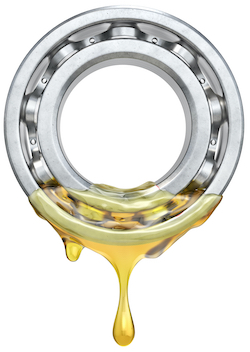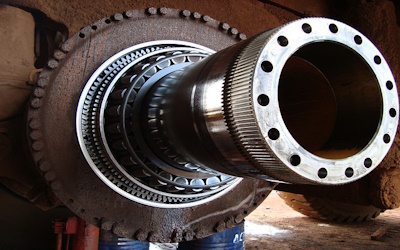The Fundamentals of Tribology Part 1: The Basics of Tribosystems

Figure 1: Bearing lubrication
Tribology is the study of wear, friction, and lubrication, and it encompasses the behavior of surfaces and other tribo-elements in natural and artificial systems under relative motion.
Tribology is a complex, multidisciplinary endeavor that brings together researchers from different disciplines. This includes mechanical engineering, manufacturing, materials science and engineering, chemistry, chemical engineering, physics, and many other fields. Biotribology, nanotribology, space tribology, and tribotronics are all subfields of tribology.
In this three-part series we will look at three main parts of tribology and the application of tribology in mechanics:
- Part 1: The basics of tribosystems
- Part 2: An in-depth look at lubrication
- Part 3: Standards, testing, and classification in tribology
Note: Currently we do not sell any lubricants.
Table of contents
- A short history of tribology
- Importance of tribology
- What are tribosystems?
- Wear and friction
- Modern applications of tribology
A short history of tribology
The word 'tribology' comes from the Greek word tribos, which means to rub, so it literally translates into 'the science of rubbing.' In the Jost Report of March 9, 1966, British mechanical engineer Peter H. Jost introduced the concept. Jost is considered the founder of the field of tribology and his report placed a greater emphasis on it. Tribology institutes were to be established, along with a textbook on tribo-design and engineering.
On September 26th, 1966, shortly following publication of the Jost Report, the Committee on tribology was formally established and charged with several duties, including:
- Advice on measures to improve technological progress and economic efficiency in the field of tribology to the minister of technology
- Serving as a tribology advisor to government departments and other bodies
- Reviewing the latest techniques in tribology and recommending them to industry
- Informing the minister of technology annually of its own activities as well as trends and developments in tribology.
Importance of tribology
In the beginning, tribology research was focused on the design and effective lubrication of machine components such as bearings. Over time, there has been a shift in tribology’s focus to include several aspects of modern technology.
Traditional applications, which fall under classical tribology, highlight the importance of tribology as it pertains to the sliding surfaces in most mechanical components, which are critical to energy efficiency and maximum life expectancy of those components. Within the transportation industry, traditional tribology research focused on reliability but in more modern times, the focus has shifted towards energy consumption and increased efficiency, resulting in more complex lubricants. For example, tribology can reduce carbon dioxide emissions by increasing energy efficiency.
In addition to the transportation industry, tribology has played a vital role in the manufacturing sector, particularly in metal-forming operations. Understanding tribology in manufacturing is important as it can increase productivity while reducing costs.
What are tribosystems?
Tribology is the study of tribosystems - physical systems of contacting surfaces. The tribosystem is influenced by a large variety of factors that need to be taken into consideration before selecting materials and an effective lubricant. Parameters include motion type, speed, temperature, load, and operating environment. Broadly speaking this can be divided into operational inputs, system structure, functional outputs, and loss outputs. Examples of each include:
Operational inputs
- Type of motion: What type of motion is the subject under? This can be sliding, rolling, impact, rolling with slipping, etc.
- Load value: What is the load and how is this load applied in terms of amplitude, frequency, and duration?
- Velocity: Which speed factor is involved?
- Temperature: Temperature involves various factors such as the ambient temperature, friction induced temperature, external heating and/or coolin, temperature gradients, and flash temperature.
System structure
The system-structure is determined by the profiles of the substantial elements, which include:
- The ground body and the counter body: This can be two surfaces sliding over each other. For example two metal surfaces that slide over each other.
- The ambient medium: An environmental medium such as air.
- The interfacial medium: For example, a lubricant that is present in between the two surfaces, such as in bearings.
These are affected by the following factors:
| Ground body and counter body | |
| Material Properties | Geometrical properties |
|
|

Figure 2: Tribology covers many different factors in mechanics. From friction in the bearings of this truck axle, to the friction between the wheels and road surface.
| Interfacial Medium | |
| Aggregate state of liquid and gasses | Aggregate state of solids |
|
|
| Ambient medium |
|
Functional outputs
Functional outputs in tribology are the result of the transformation or transfer of the operational inputs through the system structure. In essence:
Operational input > System structure > Functional outputs
Examples of functional outputs are: power, motion, information, matter, and material.
Loss outputs
Because of the nature of friction and wear, the final factor is the loss output. This includes the dissipation and loss of energy, and creation of debris. Minimizing the amount of loss outputs translates directly into minimizing and controlling financial losses more efficiently. In mechanics this can be achieved through, for example, lubrication.
Following the identification of the system and its parameters, we apply different lubricant chemistries to determine the optimal lubricant for the application. In part 2, we discuss lubrication. Also check out our article on bearing lubrication or our lubrication overview.
Wear and friction
What is friction in tribology?
The term friction refers to the resistance created by two bodies when they are in contact. Basic friction laws describe friction on a macroscopic level. They state that friction forces are linearly related to loads. It is possible to calculate a main dimensionless parameter, called the coefficient of friction often symbolized by the Greek letter µ.
The coefficient of friction describes the relationship between the force of friction between two bodies and the force pushing them together during or at the onset of the slippage process. The coefficient of friction depends on the materials used. Rubber on pavement has a high coefficient of friction, while ice on steel has a low coefficient of friction.
The amount of friction can be calculated with the following Coefficient of friction formula, where:
- μ = static (μs) or kinetic (μk) frictional coefficient
- Fn = Applied normal force
- Fr = Friction force

Figure 3: This shows the tribology system, here Fn is the force applied to the sliding surfaces, Fr is the friction force (movement), and the red line indicates the addition of lubricant which lowers the kinetic frictional coefficient.
What is wear in tribology
Wear occurs when surfaces interact irreversibly and material is lost. In a sliding pair of surfaces, elementary physical and chemical processes occur. Wear mechanisms result in material and shape changes of the friction partners. These include:
- Surface fatigue: This can cause stress fractures in the surface material
- Abrasion: Causes grooves in the surface material
- Adhesion: Transfer of material
- Tribochemical reactions: Causing the formation of particles and residues
Modern applications of tribology
From its early focus on improving the operation and extending the life of industrial machinery, tribology has evolved into a wide range of applications that have had an impact on many fields:
- Classical tribology pertains to the friction and wear in machine elements, like: brakes, rolling-element bearings, clutches, plain bearings, wheels, gears, etc.
- In recent years, Nanotribology has gained a lot of traction. Specifically, this focuses on tribological phenomena on a nanoscopic scale.
- Space tribology focuses on tribological systems that operate under harsh environmental conditions, particularly those arising from extreme temperature fluctuations in outer space.
- Green tribology explores how to minimize the impact on the environment, as well as how to reduce the loss of tribological efficiency by using technologies with minimal environmental impact.
- The field of biotribology examines lubrication in biological systems, such as human hips and knees.
- Tribotronics is a form of robotics that combines machine elements and electronic components to create active tribological systems.
- Computational tribology models the behavior of tribological systems by combining several disciplines such as contact mechanics, fracture mechanics, and computational fluid dynamics.
- Geotribology studies friction, wear, and lubrication of geological systems, such as faults and glaciers.
In this three-part series we look at three main parts of tribology and the application of tribology in Mechanics. Read on as we take an in-depth look at lubrication.



